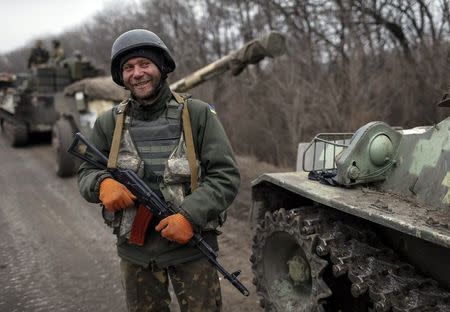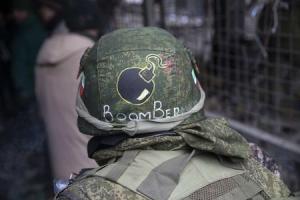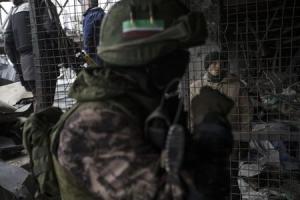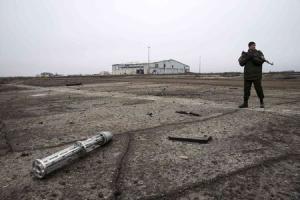 |
| A member of the Ukrainian armed forces and armoured personnel carriers smiles as they prepare to move to pull back from Debaltseve region, near Artemivsk February 26, 2015. REUTERS/Gleb Garanich |
By Alexander Shpigunov and Maria Tsvetkova
PARASKOVIYVKA/DONETSK, Ukraine (Reuters) - Ukrainian troops towed artillery away from the front line in the east on Thursday, a move that amounted to recognizing that a ceasefire meant to take effect on Feb. 15 was holding at last.
The military showed reporters seven or eight guns being towed away from the front at the village of Paraskoviyvka north of the government stronghold of Artemivsk. Earlier, Reuters journalists saw a larger convoy of 30-40 vehicles also towing guns away from the front on a highway.
The move was Kiev's most direct step to acknowledge that the ceasefire was finally holding, a week after suffering one of the worst defeats of the war at the hands of rebels who initially ignored the ceasefire to launch a major advance.
The pro-Russian rebels, who committed to the truce after their successful offensive, have been pulling back heavy weapons for two days, but Kiev had until now held back from implementing the withdrawal, arguing that fighting had not yet ceased.
However, the army reported no combat fatalities at the front for a second straight day on Thursday, the first time no troops have been killed since long before the French- and German-brokered truce was meant to take effect.
View gallery

The helmet of an armed man of the separatist self-proclaimed Donetsk People's Republic army is s …
The withdrawal of artillery is "point two" of the peace agreement reached in the Belarus capital Minsk, so beginning it amounts to an acknowledgement that "point one" - the ceasefire itself - is being observed.
"Today Ukraine has begun the withdrawal of 100 millimeter guns from the line of confrontation," the military said in a statement, saying the step would be monitored by the Organization for Security and Cooperation in Europe.
It said it reserved the right to alter the schedule of withdrawal "in the event of any attempted offensive".
Reuters journalists in rebel-held Donetsk said they had heard no artillery in the night although the occasional distant blast or gunshot could be heard during the day.
"WE DON'T RECOVER DEAD BODIES. WE MAKE THEM"
View gallery

A Ukrainian war prisoner (R) is guarded by armed men of the separatist self-proclaimed Donetsk Peopl …
Rebels brought Ukrainian war prisoners on Thursday to the ruins of the airport on the north of the town to recover the dead bodies of their fellow Ukrainian troops, left buried in the wreckage since it the terminal was captured in January.
Rebels carried out controlled explosions to blast holes through walls inside the ruined terminal and sent the prisoners down a ladder where the floor had collapsed.
Three dead bodies still lay at the site out of five that had been recovered from the debris the previous day. Prisoners said they were searching for three more they believed were still buried.
The commander of the separatist "Sparta" battalion, going by the nom de guerre "Motorola", said the prisoners had been assigned the task because "it's not our job to recover dead bodies, it's our job to make them."
"They take their comrades out to return them to their mums and dads. Did they think we would feed them for free?"
View gallery

An armed man with the separatist self-proclaimed Donetsk People's Republic army stands near the …
The airport is a totemic battlefield for both sides. Ukrainian troops had held out there for months until the rebels assaulted it after abandoning a previous ceasefire agreed in September.
The separatist rebels initially ignored the new truce last week to launch an advance that led to one of the biggest battles of a war that has killed more than 5,600 people.
But since capturing the strategic town of Debaltseve, where the rebels said the truce did not apply, they have taken pains to emphasize that they now intend to abide by it.
Western countries denounced the rebels and their presumed sponsor, Russian President Vladimir Putin, for advancing on Debaltseve after the truce was meant to take effect. But they have since held out hope that the ceasefire will now hold, with the rebels having achieved that objective.
In the days after its troops were driven from Debaltseve, Kiev maintained that it believed the rebels were reinforcing for another advance, particularly expressing fear for the city of Mariupol, a port of 500,000 people.
Western countries have threatened to impose new economic sanctions on Moscow if the rebels advance further into territory the Kremlin calls "New Russia".
Moscow, which denies aiding its sympathizers in Ukraine, said on Thursday the threats of more sanctions were cover for Western efforts to undermine the truce.
"It's an attempt to ... distract attention from the necessity to fulfill the conditions of the Minsk agreements," Foreign Minister Sergei Lavrov said.
(Additional reporting by Natalia Zinets and Pavel Polityuk in Kiev and Maria Tsvetkova in Donetsk, Ukraine; additional reporting and writing by Peter Graff; editing by Mark Trevelyan)